Nanoindentation and Microstructure in the Shear Band in a Near Beta Titanium Alloy Ti-5Al-5Mo-5V-1Cr-1Fe
Abstract
1. Introduction
2. Materials and Experiments
3. Results
3.1. Mechanical Properties of the Shear Band
3.2. Microstructure in the Shear Band
4. Discussion
5. Conclusions
Author Contributions
Funding
Acknowledgments
Conflicts of Interest
References
- Lai, M.J.; Li, T.; Raabe, D. ω phase acts as a switch between dislocation channeling and joint twinning- and transformation-induced plasticity in a metastable β titanium alloy. Acta Mater. 2018, 151, 67–77. [Google Scholar] [CrossRef]
- Singh, P.; Pungotr, H.; Kalsi, N.S. On the characteristics of titanium alloys for the aircraft applications. Mater. Today Proc. 2017, 4, 8971–8982. [Google Scholar] [CrossRef]
- Li, J.; Zhou, J.; Feng, A.; Huang, S.; Meng, X.; Sun, Y.; Sun, Y.; Tian, X.; Huang, Y. Investigation on mechanical properties and microstructural evolution of TC6 titanium alloy subjected to laser peening at cryogenic temperature. Mater. Sci. Eng. A 2018, 734, 291–298. [Google Scholar] [CrossRef]
- Wang, W.; Huang, R.; Zhao, Y.; Liu, H.; Huang, C.; Yang, X.; Shan, Y.; Zhao, X.; Li, L. Adjustable zero thermal expansion in Ti alloys at cryogenic temperature. J. Alloys Compd. 2018, 740, 47–51. [Google Scholar] [CrossRef]
- Fan, J.K.; Li, J.S.; Zhang, Y.D.; Kou, H.; Germain, L.; Esling, C. Formation and crystallography of nano/ultrafine-trimorphic structure in metastable beta titanium alloy Ti-5Al-5Mo-5V-3Cr-0.5Fe processed by dynamic deformation at low temperature. Mater. Charact. 2017, 130, 149–155. [Google Scholar] [CrossRef]
- Kad, B.K.; Gebert, J.M.; Perez-Prado, M.T.; Kassner, M.E.; Meyers, M.A. Ultrafine-grain-sized zirconium by dynamic deformation. Acta Mater. 2006, 54, 4111–4127. [Google Scholar] [CrossRef]
- Wang, B.F.; Sun, J.; Wang, X.; Fu, A. Adiabatic shear localization in a near beta Ti–5Al–5Mo–5V–1Cr–1Fe alloy. Mater. Sci. Eng. A 2015, 639, 526–533. [Google Scholar] [CrossRef]
- Li, Z.Z.; Wang, B.F.; Zhao, S.; Valiev, R.Z.; Vecchio, K.S.; Meyers, M.A. Dynamic deformation and failure of ultrafine-grained titanium. Acta Mater. 2017, 125, 210–218. [Google Scholar] [CrossRef]
- Wang, B.F.; Wang, X.Y.; Li, Z.; Ma, R.; Zhao, S.; Xie, F.; Zhang, X. Shear localization and microstructure in coarse grained beta titanium alloy. Mater. Sci. Eng. A 2016, 652, 287–295. [Google Scholar] [CrossRef]
- Yang, Y.; Jiang, F.; Zhou, B.M.; Li, X.M.; Zheng, H.G.; Zhang, Q.M. Microstructural characterization and evolution mechanism of adiabatic shear band in a near beta-Ti alloy. Mater. Sci. Eng. A 2011, 528, 2787–2794. [Google Scholar] [CrossRef]
- Li, Z.Z.; Zhao, S.; Wang, B.F.; Cui, S.; Chen, R.; Valiev, R.Z.; Meyers, M.A. The effects of ultra-fine-grained structure and cryogenic temperature on adiabatic shear localization in titanium. Acta Mater. 2019, 408–422. [Google Scholar] [CrossRef]
- Wang, B.F.; Ma, R.; Zhou, J.; Li, Z.; Zhao, S.; Huang, X. Adiabatic shear localization in ultrafine grained 6061 aluminum alloy. Mater. Sci. Eng. A 2016, 675, 221–227. [Google Scholar] [CrossRef]
- Wang, B.F.; Sun, J.; Hahn, E.; Wang, X. Shear Localization and its Related Microstructure Mechanism in a Fine-Grain-Sized Near-Beta Ti Alloy. J. Mater. Eng. Perform. 2015, 24, 477–483. [Google Scholar] [CrossRef]
- Jiang, Y.; Chen, Z.; Zhan, C.; Chen, T.; Wang, R.; Liu, C. Adiabatic shear localization in pure titanium deformed by dynamic loading: Microstructure and microtexture characteristic. Mater. Sci. Eng. A 2015, 640, 436–442. [Google Scholar] [CrossRef]
- Wang, B.F.; Yao, X.; Liu, L.; Zhang, X.; Ding, X. Mechanical properties and microstructure in a fine grained Ti-5Al-5Mo-5V-1Cr-1Fe titanium alloy deformed at a high strain rate. Mater. Sci. Eng. A 2018, 736, 202–208. [Google Scholar] [CrossRef]
- Ran, C.; Chen, P.; Li, L.; Zhang, W. Dynamic shear deformation and failure of Ti-5Al-5Mo-5V-1Cr-1Fe titanium alloy. Mater. Sci. Eng. A 2017, 694, 41–47. [Google Scholar] [CrossRef]
- Jonas, J.J.; Aranas, C., Jr.; Fall, A.; Jahazi, M. Transformation softening in three titanium alloys. Mater. Des. 2017, 113, 305–310. [Google Scholar] [CrossRef]
- Lu, S.J.; Zhang, B.; Li, X.Y.; Zhao, J.W.; Zaiser, M.; Fan, H.D.; Zhang, X. Grain boundary effect on nanoindentation: A multiscale discrete dislocation dynamics model. J. Mech. Phys. Solids 2019, 126, 117–135. [Google Scholar] [CrossRef]
- Liu, X.; Zhang, Q.; Zhao, X.; Yang, X.; Luo, L. Ambient-temperature nanoindentation creep in ultrafine-grained titanium processed by ECAP. Mater. Sci. Eng. A 2016, 676, 73–79. [Google Scholar] [CrossRef]
- Renner, E.; Gaillard, Y.; Richard, F.; Amiot, F.; Delobelle, P. Sensitivity of the residual topography to single crystal plasticity parameters in Berkovich nanoindentation on FCC nickel. Int. J. Plast. 2016, 77, 118–140. [Google Scholar] [CrossRef]
- Rabadia, C.D.; Liu, Y.J.; Zhao, C.H.; Wang, J.C.; Jawed, S.F.; Wang, L.Q.; Chen, L.Y.; Sun, H.; Zhang, L.C. Improved trade-off between strength and plasticity in titanium based metastable beta type Ti-Zr-Fe-Sn alloys. Mater. Sci. Eng. A 2019, 766, 138340. [Google Scholar] [CrossRef]
- Salvado, F.C.; Teixeira-Dias, F.; Walley, S.M.; Lea, L.J.; Cardoso, J.B. A review on the strain rate dependency of the dynamic viscoplastic response of FCC metals. Prog. Mater. Sci. 2017, 88, 186–231. [Google Scholar] [CrossRef]
- Sun, F.; Li, J.; Kou, H.; Tang, B.; Tang, B.; Chen, Y.; Chang, H.; Cai, J. β phase transformation kinetics in Ti60 alloy during continuous cooling. J. Alloys Compd. 2013, 576, 108–113. [Google Scholar] [CrossRef]
- Meyers, M.A.; Xu, Y.B.; Xue, Q.; Pérez-Prado, M.T.; McNelley, T.R. Microstructural evolution in adiabatic shear localization in stainless steel. Acta Mater. 2003, 51, 1307–1325. [Google Scholar] [CrossRef]
- Pilling, J.; Livesey, D.W.; Hawkyard, J.B.; Ridley, N. Solid states bonding in superplastic Ti-6Al-4V. Met. Sci. 1984, 18, 117–122. [Google Scholar] [CrossRef]
- Semiatin, S.L.; Soper, J.C.; Sukonnik, I.M. Short-time beta grain growth kinetics for a conventional titanium alloy. Acta Mater. 1996, 44, 1979–1986. [Google Scholar] [CrossRef]

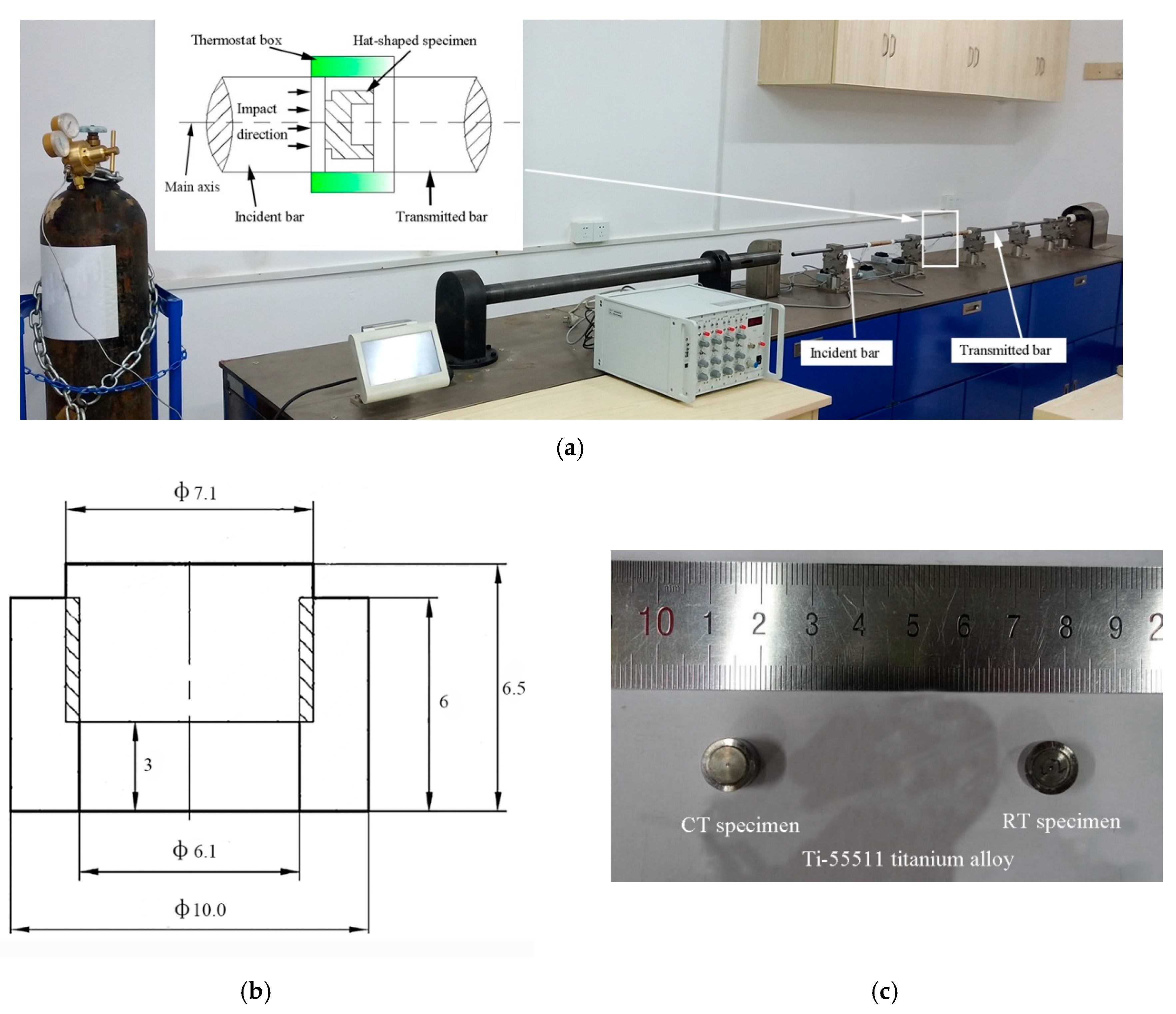
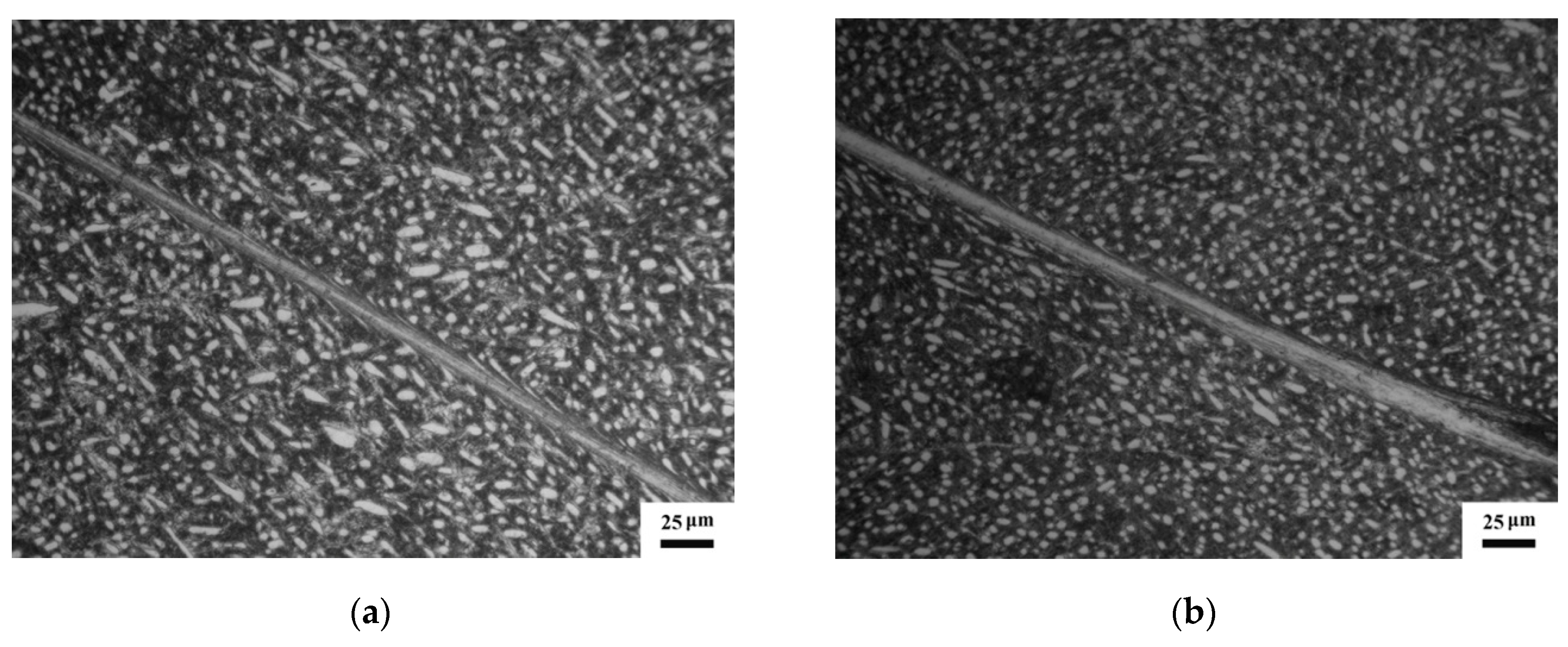
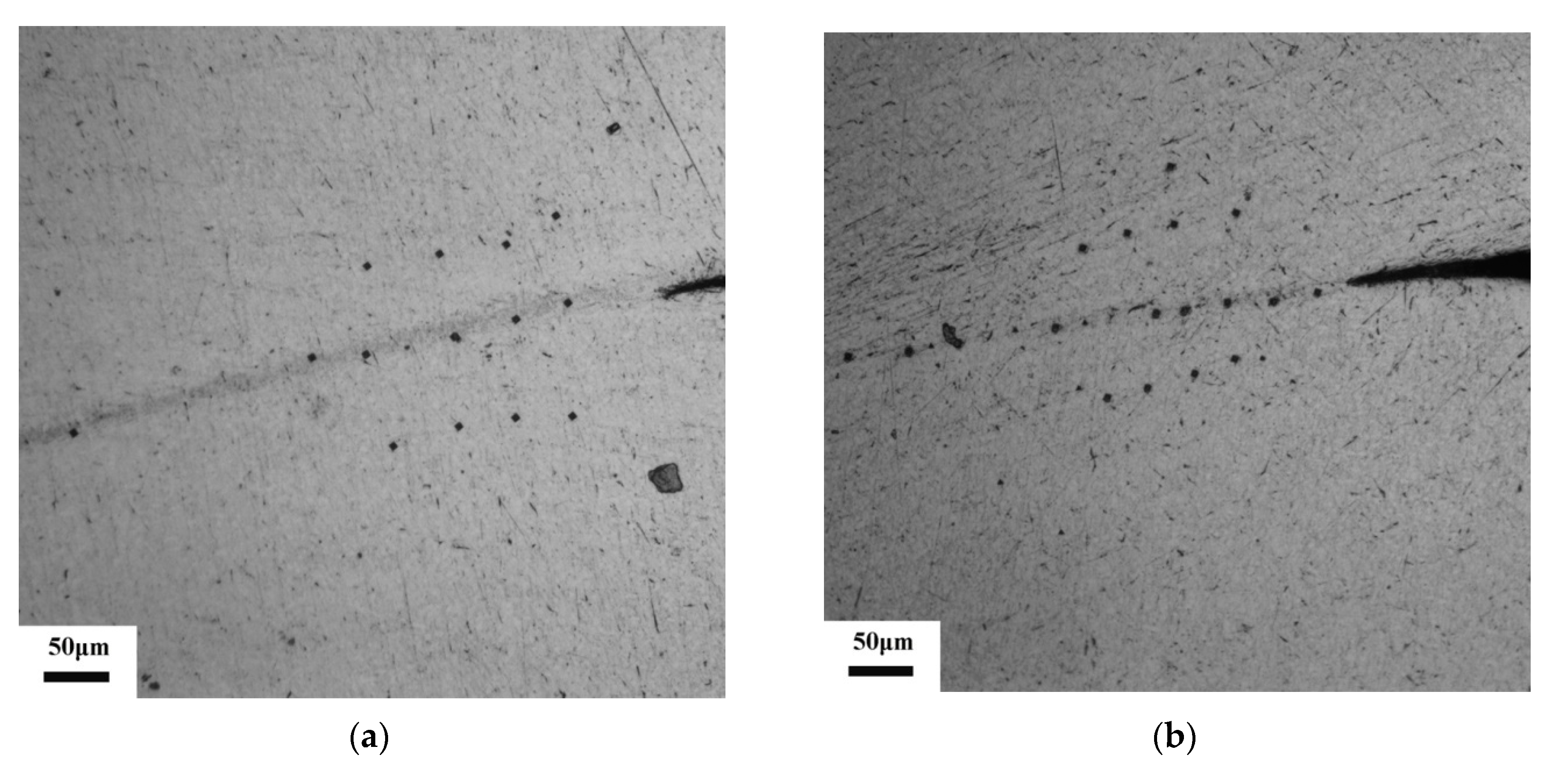


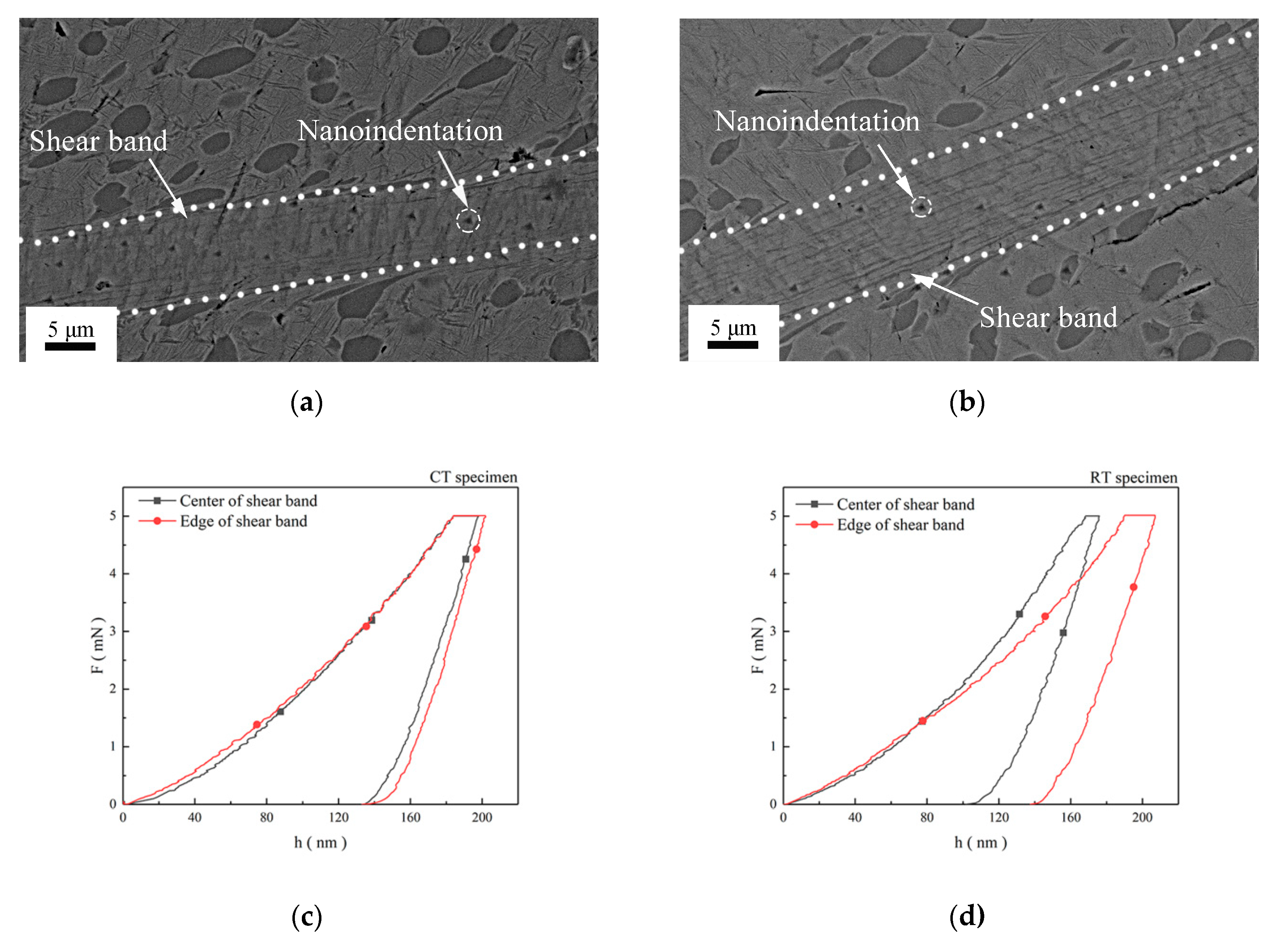

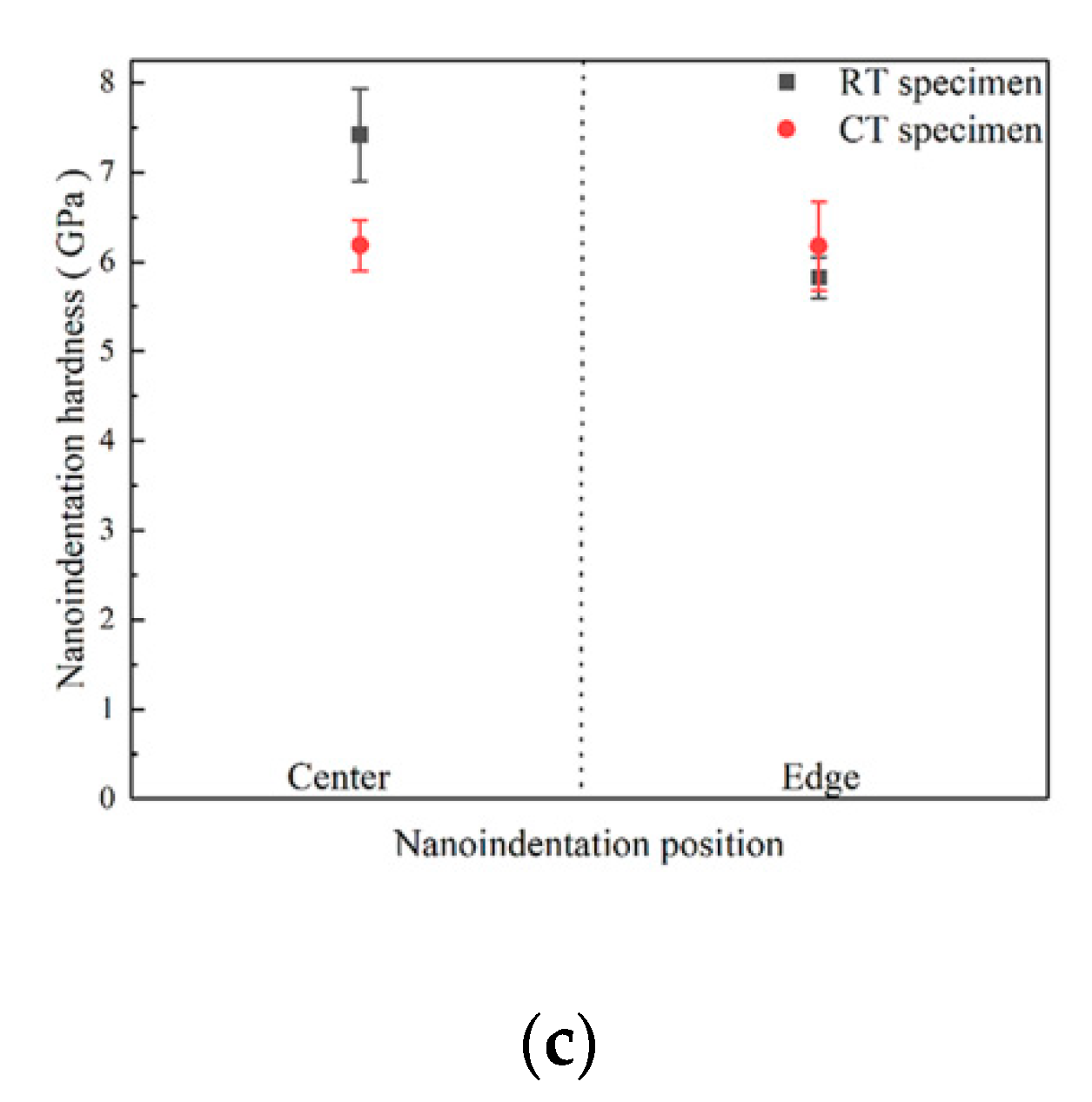
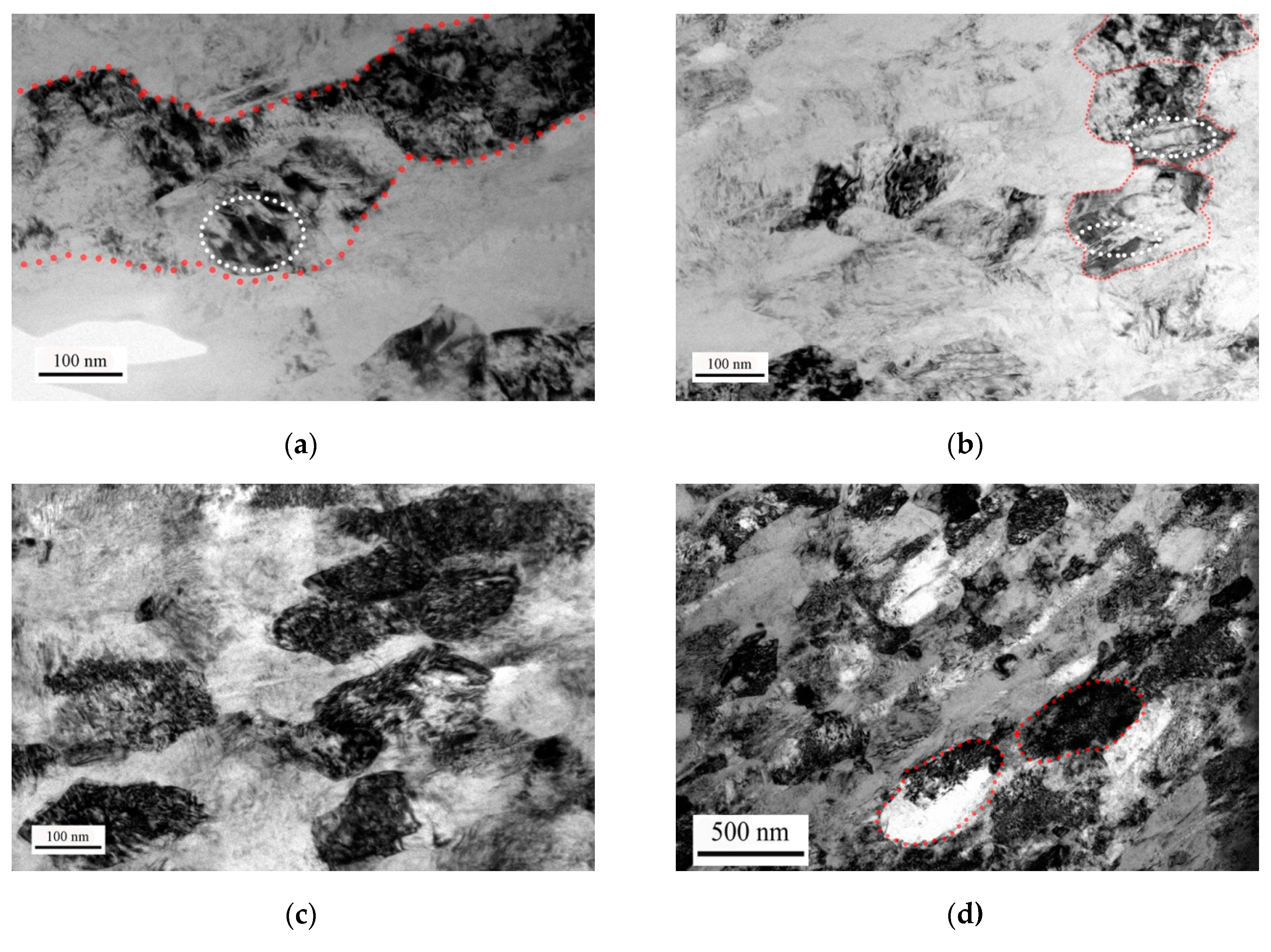
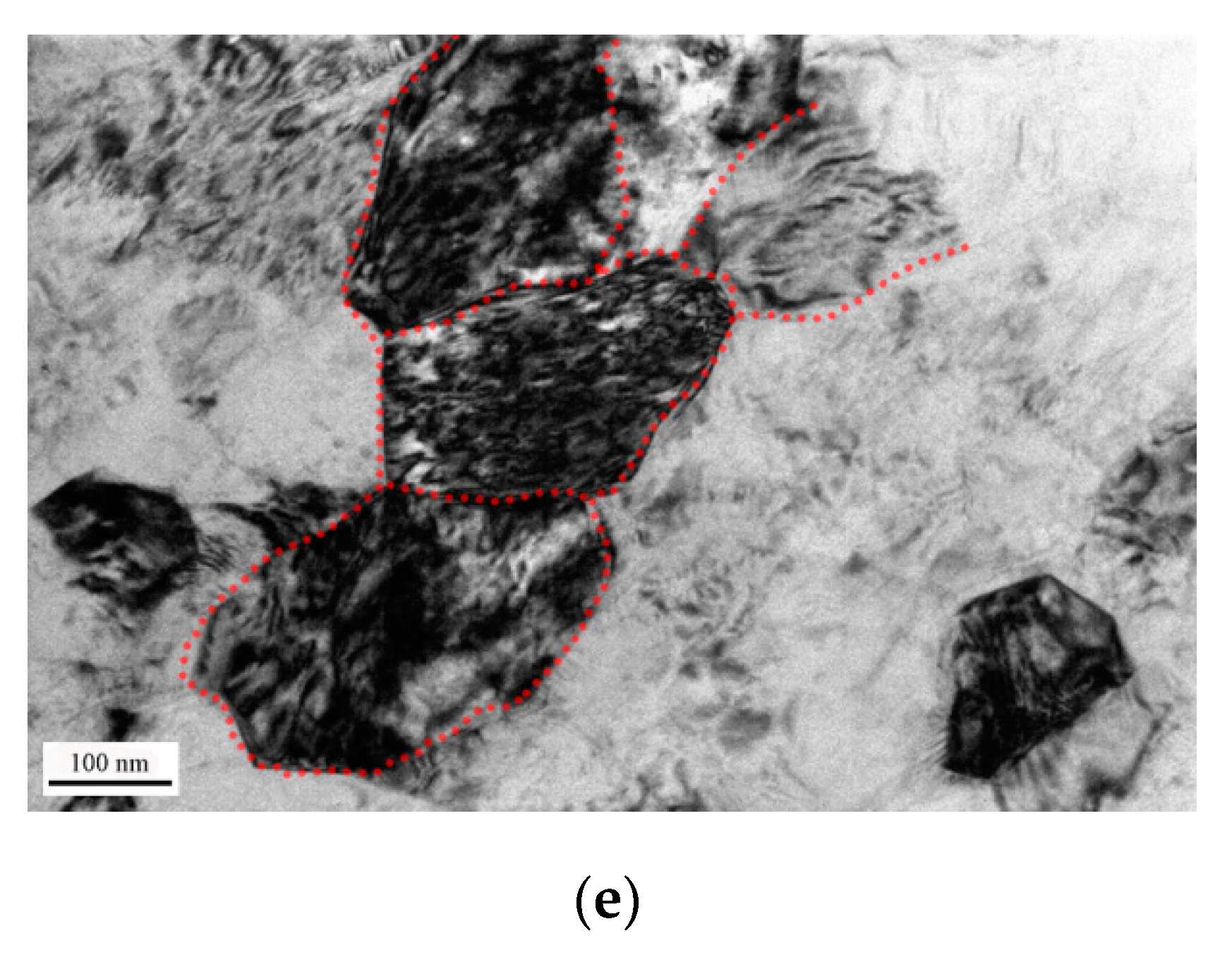

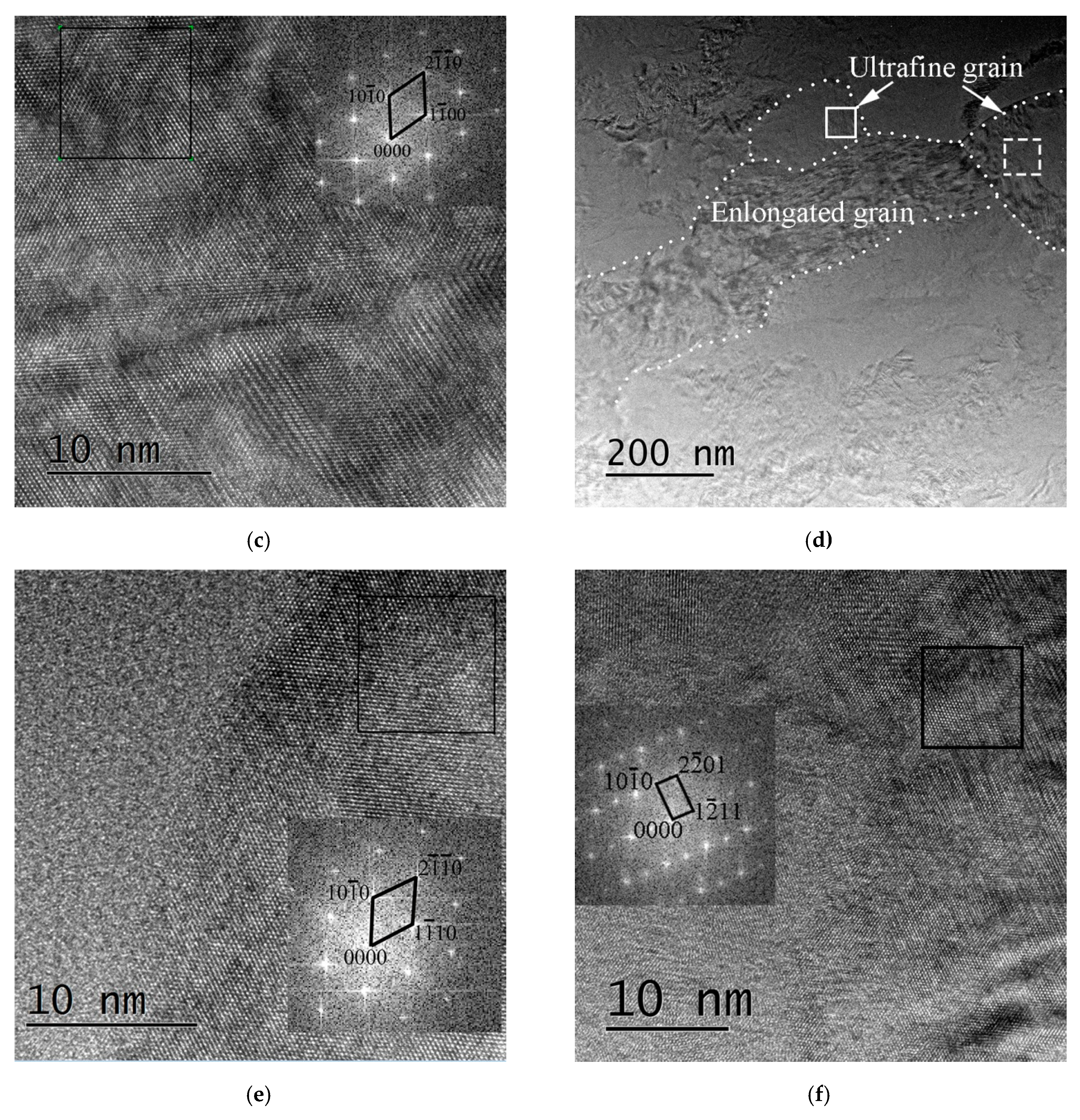
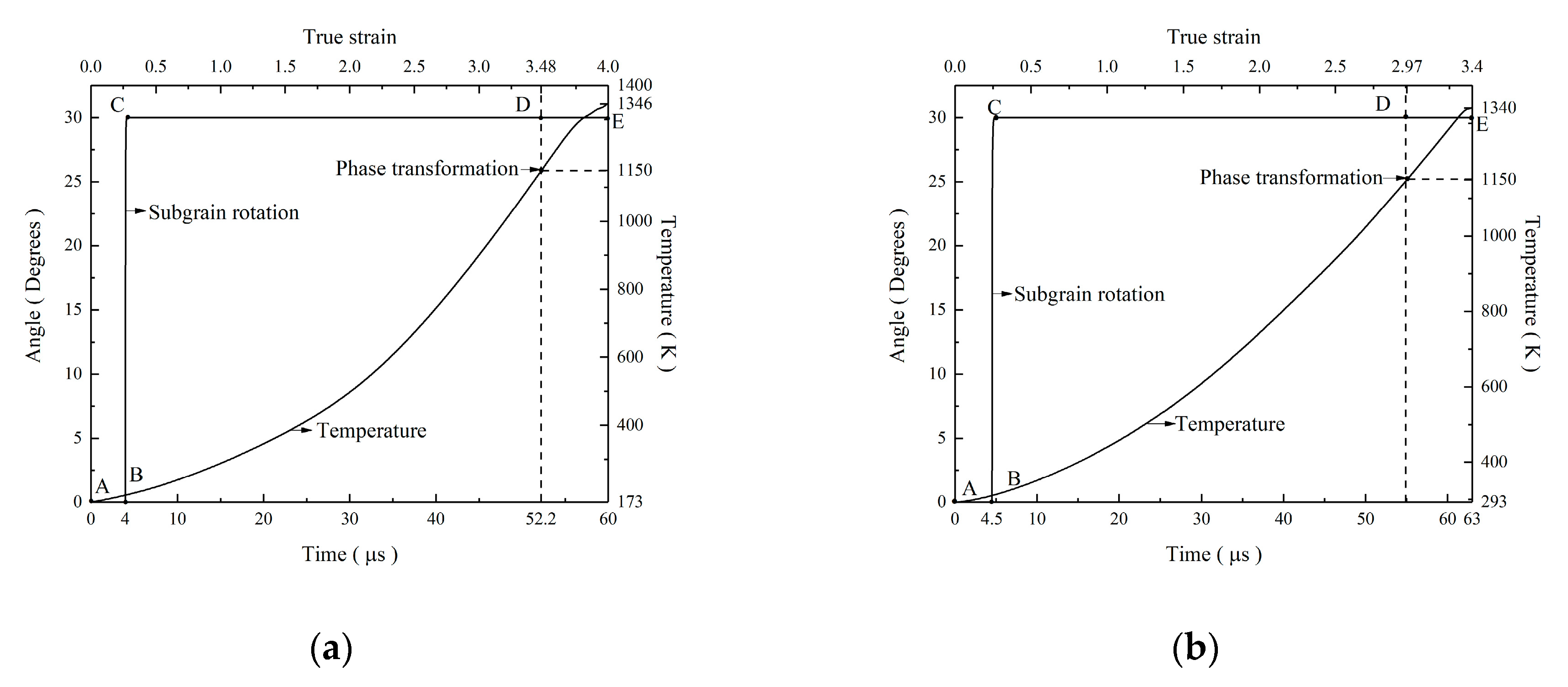
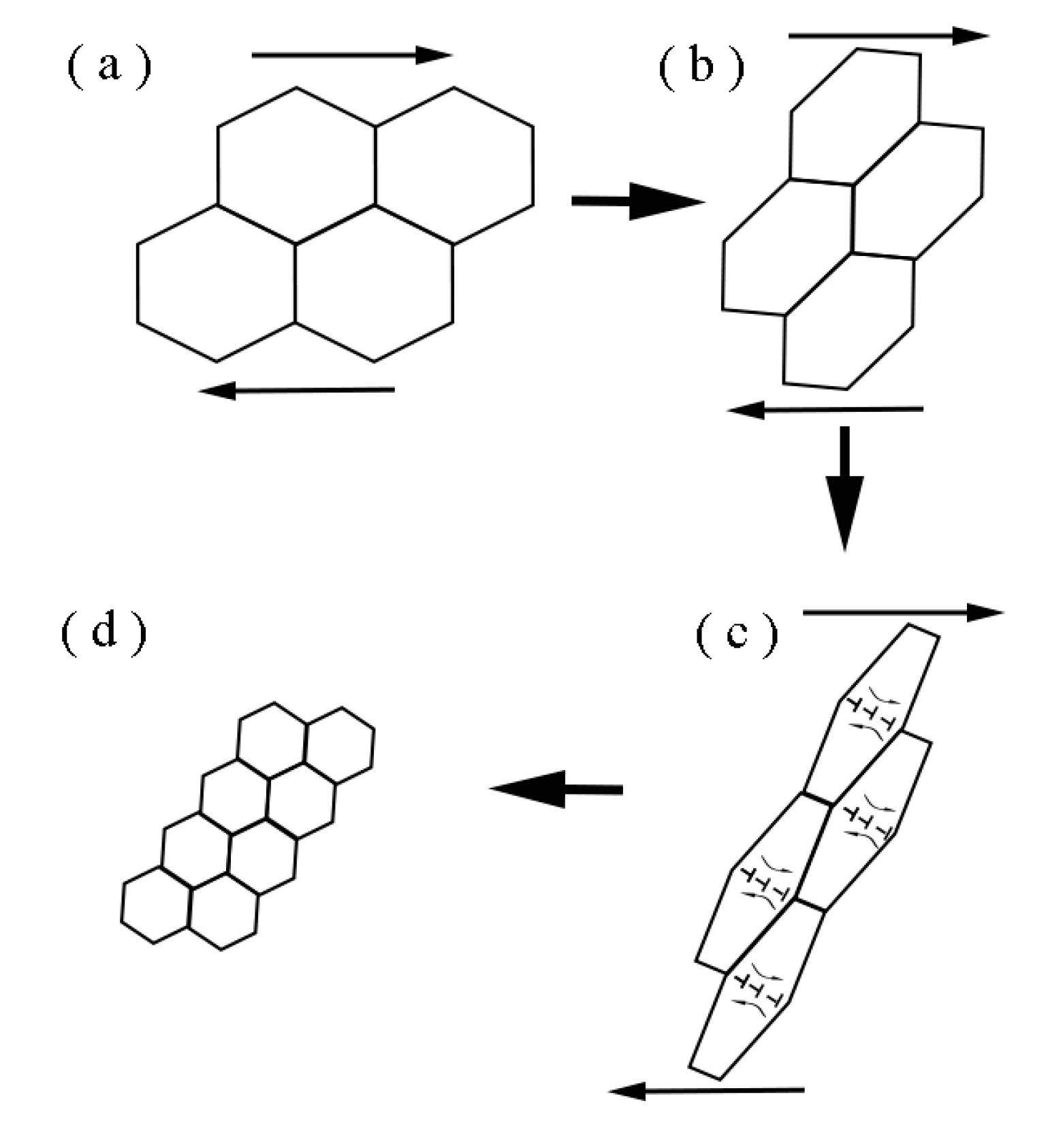
| Elements | Al | Mo | V | Cr | Fe | Ti |
|---|---|---|---|---|---|---|
| Compositions (wt.%) | 5.59 | 5.31 | 4.24 | 1.27 | 1.18 | Balance |
© 2019 by the authors. Licensee MDPI, Basel, Switzerland. This article is an open access article distributed under the terms and conditions of the Creative Commons Attribution (CC BY) license (http://creativecommons.org/licenses/by/4.0/).
Share and Cite
Wang, B.; Ding, X.; Mao, Y.; Liu, L.; Zhang, X. Nanoindentation and Microstructure in the Shear Band in a Near Beta Titanium Alloy Ti-5Al-5Mo-5V-1Cr-1Fe. Materials 2019, 12, 4065. https://doi.org/10.3390/ma12244065
Wang B, Ding X, Mao Y, Liu L, Zhang X. Nanoindentation and Microstructure in the Shear Band in a Near Beta Titanium Alloy Ti-5Al-5Mo-5V-1Cr-1Fe. Materials. 2019; 12(24):4065. https://doi.org/10.3390/ma12244065
Chicago/Turabian StyleWang, Bingfeng, Xu Ding, Ying Mao, Lanyi Liu, and Xiaoyong Zhang. 2019. "Nanoindentation and Microstructure in the Shear Band in a Near Beta Titanium Alloy Ti-5Al-5Mo-5V-1Cr-1Fe" Materials 12, no. 24: 4065. https://doi.org/10.3390/ma12244065
APA StyleWang, B., Ding, X., Mao, Y., Liu, L., & Zhang, X. (2019). Nanoindentation and Microstructure in the Shear Band in a Near Beta Titanium Alloy Ti-5Al-5Mo-5V-1Cr-1Fe. Materials, 12(24), 4065. https://doi.org/10.3390/ma12244065




